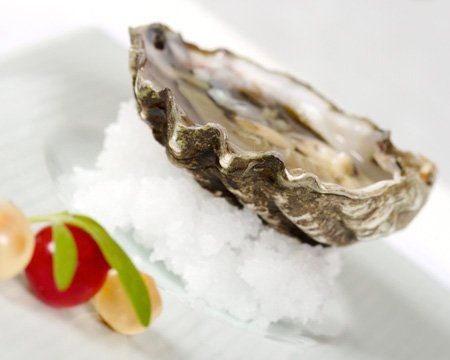Blue Point Oysters — The Real Thing
April 30 each year is always kind of a sad occasion for me, because that's the last day of the year that I eat oysters, until September rolls around. Yes, I'm a slave to that old "only in months with an 'r'" routine. Now, I know that there are perfectly good oysters produced in the United States in the warmer months (the whole "r" business got started because some European oysters brood their young in the summertime, growing milky and less appetizing) — and in fact, some of the best oysters I can remember ever having eaten were some Martha's Vineyards I got talked into consuming one July — but I cling to the tradition. Maybe that's partially because I like oysters a lot and on some level suspect that I might get tired of them if I don't give myself a few months off. My seasonal observance also gives me an excuse, of course, to gorge on oysters at the end of April. This year, I managed to dispatch a few dozen perfect Blue Points — which were once America's most famous.
Oysters were being harvested commercially in the Great South Bay, between Fire Island and the town of Blue Point on Long Island's Suffolk County coastline, as long ago as the early 1800s, and so-called Blue Point oysters became famous in the finest restaurants of New York City and beyond — and were even said to have found their way to London, where Queen Victoria pronounced them her favorite.
They were so much in demand, in fact, that counterfeits started showing up — or at least the Blue Point name started getting applied to similar-looking oysters from other parts of the Eastern Seaboard. The situation got so bad that the New York State Legislature passed a law in 1908 restricting use of the name to oysters that had been cultivated in the Great South Bay. Of course New York State law didn't much bother entrepreneurs from New Jersey, Connecticut, and elsewhere, so non-Blue Point versions continued to proliferate — all the more so after the original beds became depleted.
Twenty or 30 years ago in America, Blue Points were virtually the only oyster you'd ever find listed on a menu. It was sort of automatic: There was Lake Superior whitefish, Long Island duckling, Colorado lamb — and Blue Point oysters. For generations, these Blue Points were actually harvested from the Long Island Sound off Bridgeport, Norwalk, and other Connecticut cities. These could be very good oysters, and in fact Connecticut Blue Points are still, to my taste, one of the better oysters coming out of the thriving New England oyster industry. In 1995, though, an oysterman named Chris Quartuccio, of Blue Island Shellfish Farms (he's also the man responsible for the excellent "new" variety called Naked Cowboy), revived the oyster beds off Blue Point, Long Island, itself, and his Blue Island Shellfish Farms is today the only supplier of what I suppose must be called original Blue Points.
Although there are now scores of wonderful oysters coming from New York State, Connecticut, Rhode Island, Massachusetts, and Maine, Blue Points stand out. They're a kind of classic oyster, medium in size, firm in texture, just briny enough, with a clean, lightly metallic aftertaste. If I weren't so damn silly, I'd happily eat them all summer long.
Check out these 7 Outstanding Oyster Recipes.
